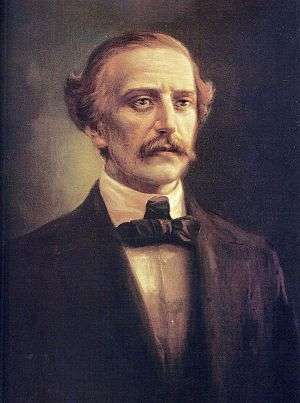Abelardo Rodríguez Urdaneta
| Abelardo Rodríguez Urdaneta | |
|---|---|
 | |
| Born |
Abelardo Rodríguez Urdaneta June 24, 1870 Santo Domingo, Dominican Republic |
| Died | 1933 |
| Occupation | Sculptor, painter, photographer |
Abelardo Rodríguez Urdaneta (born in Santo Domingo, Dominican Republic 1870–1933) was a Dominican sculptor, photographer, painter and educator. He is considered to be one of the founders of modern Dominican sculpture.[1][2]
Early life
Urdaneta studied painting and sculpture in the workshop of Juan Fernández Corridor and Cruz, a Spanish painter, who opened an academy in the city of Santo Domingo from 1883 to 1886. Later he attended the workshop of Dominican painter Luis Desangles Lubiles (Sisito). He was also an apprentice of Photography in the studios of July Pou and shared photographic and sculptural techniques with Spanish photographer and sculptor Frank ADROVER Mercadal. He also received guidance from Cordiglia, who came to Santo Domingo in 1884 from Venezuela.
Career
In 1898 his photo of Arthur B. Pellerano Alfau was published, considered to be the first photograph published in a Dominican magazine. Since 1901 he worked in his photographic studio and cultural center in the city of Santo Domingo, visited by personalities from politicians and artists including José Martí and Hostos.
In 1903 he conducted the historic and celebrated sculpture "One of many" a wounded soldier, left on the ground, with torn clothes and bare chest, one of the works for which he obtained the most recognition in the Republic and the world. In 2009 this sculpture was removed due to remodeling the current Galicia Park. According to information received from the families of local authorities, the work was restored but would be relocated elsewhere.
In 1908 with support from the Central Government he opened an academy of drawing, painting and sculpture that helped to train many young people of the time. His engravings reproduced notable visitors, ruins, palaces, gates, colonial facades, bankers, intellectuals and teachers.
His creative work was composed of a large number of portraits, busts, statues, monuments and reliefs in which he collected important moments in Dominican history that reflected the life of governors, patricians, merchants, community leaders and families of the time. His school remained active until 1933, the year of his death.
Politics
He was a vocal opponent of the First American Intervention. His "Invocación" poster in which the Dominican Republic is represented as a female figure with arms raised and hands held by the claws of an eagle, became widely circulated throughout the country.
Selected works

- El Extraviado
- Los Jugadores
- Juramento de Duarte
- Cupido
- Pedazo de costa
- Recuerdos del Sur,
- El Menphis,
- El Castini
- A la mar
- Paisaje del crepúsculo
- Barcas
- Abnegación
- La libertad de Cuba
- (El asesinato del Presidente Ramón Cáceres
- Horacio Vásquez
- Escudo Constitucional Dominicano
- La figura de Juan Pablo Duarte
- La Libertad
- La Independencia
- Invocación
- Cabeza de indio Siboney
- Los náufragos del tres de Septiembre
- El último Tributo
References
- ↑ National Geographic Traveler: Dominican Republic - Christopher P. Baker - Google Books. Books.google.com. Retrieved 2014-05-23.
- ↑ "Dominican Republic | COINED Spanish Experiences". Intercoined.com. Retrieved 2014-05-23.